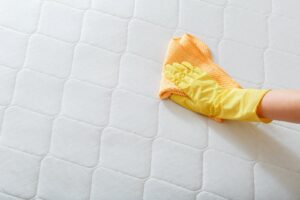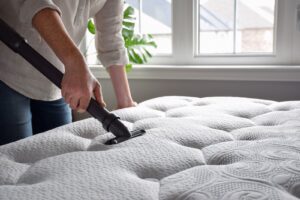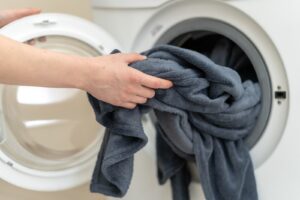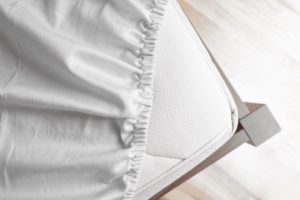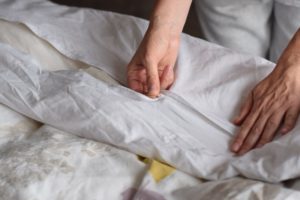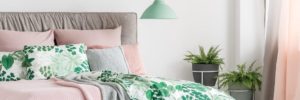Quilt vs. Comforter vs. Duvet
Quilts, comforters, and duvets are common bedding types. They can all help keep sleepers warm and comfortable, but they achieve this in different ways. For example, a duvet usually combines a separate insert and cover, while a comforter has the cover built in. Meanwhile, a quilt is made of an insulating layer stitched between two layers of fabric.
We’ll discuss quilts, comforters, and duvets, including the different kinds, the materials used to make them, and how they perform for different sleepers. We’ll also review care and cleaning instructions so you can select the option that works best with your needs and preferences.
What is a Quilt?
Quilts are multilayered blankets made by sandwiching a layer of batting between two layers of fabric. The stitching used to secure these layers may be a simple square or a more intricate pattern. Because of the construction and the materials used to make them, quilts are generally thinner than other kinds of bedding and may not be as warm. However, unlike duvets, they do not require an extra cover.
Wholecloth quilts tend to be the most common kind of quilt available from bedding manufacturers. These quilts use a single piece of fabric for the top layer. The top and bottom layers are often made of cotton, while the batting is usually made from cotton, wool, or down.
Traditional patchwork quilts use several smaller pieces of fabric to form the upper layer of the quilt. Patchwork quilts are often handmade and may incorporate special designs or repurpose meaningful materials. These quilts have sentimental value and can become important family keepsakes.
Some quilts are machine-washable, but you may need to use a large-capacity washer and dryer to ensure proper cleaning. Handmade or heirloom quilts usually require special care and may be more delicate. Following the suggested care instructions is important for all bedding.
While handmade quilts can be quite expensive, there are more affordable options available from various bedding retailers. Also, since many quilts are reversible, one quilt can potentially last through many different changes in bedroom decor.
Pros & Cons of a Quilt
| Pros | Cons |
|---|---|
|
|
What is a Comforter?
Comforters are usually made from two layers of a cotton or polyester blend fabric sewn together and then packed with down, down alternative, cotton, or wool. A comforter’s design may include chambers in the middle to help keep the fill evenly distributed and minimize flattening over time.
Available in a range of colors, patterns, and styles, comforters do not require a separate cover the way a duvet does. However, some sleepers might choose to use a cover or sleep with a flat sheet to keep the comforter cleaner between washes.
Comforters tend to have less loft than a duvet, which means they might not be as warm and may require the use of an extra blanket during colder months.
While some comforters are machine-washable, they are often too bulky for a conventional washer and dryer. Be sure to follow the recommended care instructions to extend the life of the comforter and help ensure the fill performs at its best.
Comforter prices vary depending on the type of fabric and fill used, as well as the quality of the craftsmanship. Shoppers may be able to save money by purchasing a comforter as part of a bedding set, which has the added bonus of making it easier to coordinate the comforter with sheets and any other bedding.
Pros & Cons of a Comforter
| Pros | Cons |
|---|---|
|
|
What is a Duvet?
Duvets are similar to comforters in terms of basic construction. The biggest difference is that they are designed to be used with a separate duvet cover, while comforters have a cover built in.
Duvet comes from the French word for down, the soft, fluffy feathers on the stomach and chest of waterfowl that keep the birds warm and insulated from the water. Duvet inserts were originally filled with down because of the natural loft and coziness. Many duvet inserts still use down, but there are also other fill options such as down alternative, wool, and cotton.
Duvets are essentially big fabric pockets that may or may not be sewn with squares or other shapes to keep the fill from shifting. The insert is encased in a duvet cover and fastened at the corners with strings or buttons. Duvet covers protect the insert from dirt and provide additional decoration. Many cover options exist, making it easy to change the look and feel of your bed covering.
When used with a regularly washed cover, duvet inserts only need washing once or twice a year. Some duvets can be machine-washed in large-capacity washers and dryers, but others require dry cleaning. Following the care instructions from the manufacturer can improve the longevity of the duvet.
Duvets can be more expensive than comforters or quilts, especially duvets with down fill. However, you may only have to replace the cover rather than the entire duvet at any given time, making it a potentially good investment.
Pros & Cons of a Duvet Insert
| Pros | Cons |
|---|---|
|
|
Quilt vs. Comforter vs. Duvet
Quilts, comforters, and duvets can all provide sleepers with warmth and comfort. But there are some key differences that may make one work better than another for each individual sleeper.
Quilts feature a decorative pattern or design sewn into their top layer. They may also be composed of patchwork pieces. Quilts tend to lie flatter than a comforter or duvet, but this will depend on the materials used to make them. Many quilts have a reversible design, meaning they can be used with either side up, which can make them a good choice for anyone who wants to rotate their bedding.
Comforters and duvets are often confused with each other, but the main difference is that duvets are designed for use with a cover, while comforters can be used without one. A duvet cover can help keep a duvet insert from getting dirty, leading to a longer lifespan and a warmer bed covering. However, comforters are often easier to clean and can work well for those in warmer climates who want to sleep cooler.
Washing and caring for these bed coverings depends on their construction. Some durable fabrics may be machine-washed and dried at home, while other, more delicate materials will likely come with special care instructions. Duvets used with covers will likely need washing only once or twice a year, while comforters may need cleaning more often, especially if they aren’t used along with a flat sheet or cover. Washing instructions for quilts will vary depending on the fabric and whether they’re handmade.
The look of a quilt or comforter is built-in, whereas the removable cover of a duvet allows for easy changes to suit different seasons or aesthetics. All three bedding options come in a wide range of colors and designs.
| Category | Quilt | Comforter | Duvet |
|---|---|---|---|
| Durability | Machine-crafted wholecloth quilts hold up well to regular washing when made with quality materials. Take greater care with hand-sewn quilts, which are more fragile, especially as they age. | Comforters are quite durable, depending on the fabric and fill materials. Wash and dry comforters according to the care instructions. However, be aware that comforter fills tend to go flat over time. | The use of a cover gives duvets added protection against dirt and stains, so duvets don’t need to be washed as often. This limited exposure to wear and tear means duvets tend to last longer than both quilts and comforters. |
| Warmth & Loft | Quilts tend to use lighter-weight materials compared to comforters and duvets. This means they are likely to be less warm. Quilts work well during the warmer months of the year or in places with mild winters. They may also be a good choice for hot sleepers. | A comforter’s warmth and loft depend on the type of materials used to make it. Comforters are generally thicker than quilts but thinner and less airy than duvets. During the cooler months, some sleepers may need an additional blanket. | Duvets typically have the highest loft and provide the most warmth. Down-filled duvets will be the plushest and warmest. Duvets are a good option for cold weather and for sleepers who tend to run cool. |
| Cost | Quilts are found at a wide range of price-points. The cost of a quilt depends on the quality of the materials used and the craftsmanship. Machine-made quilts cost less than those sewn by hand. | Comforter prices vary widely. Better materials and finer fills will cost more. Buying a comforter as part of a bedding bundle can be a cost-effective strategy for those on a tighter budget. | A traditional down duvet will usually be more expensive than a quilt or a comforter. However, duvets are available at many different price-points, depending on the materials. Those budgeting for a duvet should also factor in the cost of a duvet cover. |
| Style | Quilt styles run the gamut from traditional to modern. Some are handmade, while others are mass-produced. Either way, a quilt’s construction allows for a wide range of style options, including both patterns and solid colors. | Comforters are available in a wide variety of styles and colors. However, if shoppers want to change the aesthetic of their bedding, they will need to purchase a new comforter. | Duvet covers may be solid, printed, embroidered, or plain, and they are available in an array of colors. This makes it easy to change a bedroom’s style just by purchasing a new duvet cover. |
| Cleaning & Care | Store-bought, machine-made quilts are relatively durable and easy to wash. However, homemade quilts may be fragile and delicate. These quilts can require special care when washing and drying. | The type of care a comforter requires depends on the type of materials used in its construction. Following the care instructions can keep a comforter from getting damaged and to extend its lifespan. Machine-washable comforters may require the use of large-capacity washers and dryers. | Duvets need less frequent cleaning than comforters or quilts because the covers can be removed and washed. Specific cleaning instructions will depend on the fabric and fill. It’s important to follow the care instructions to avoid damaging the duvet. |
| Seasonal Needs | Because they tend to be thinner than comforters or duvets, quilts can be a good option for the summer months. | Comforters offer mid-level loft and coziness. However, it may be necessary to add another blanket for the winter. | Duvets are thick and comfortable, making them good for colder weather. However, they may be too heavy for the warmer months. |
Which Should You Choose?
Quilts, comforters, and duvets can all be comfortable for just about any sleeper. However, choosing the best option for you will depend on your specific needs and preferences.
Sleepers who live in warmer climates may prefer quilts, which tend to sleep cooler compared to duvets and comforters. Quilts also tend to be less bulky than other options. Additionally, a quilt may have special meaning if it was made by a friend or family member.
Comforters offer a wide range of options in terms of colors and materials. The all-in-one design means there’s no need for an additional cover, and the weight of a comforter makes it a good year-round choice for many sleepers regardless of weather.
Those who like a softer feel and more loft may prefer a duvet. The construction of a duvet could be a good fit for those who sleep cool, and there is always the option of changing the cover for easier cleaning and more style options.
You May Prefer Quilts If:
- You have a family heirloom you want to display
- You want bedding that requires less frequent washing
- You live in a more moderate climate
You May Prefer Comforters If:
- You want an all-in-one bed covering that doesn’t require an extra cover
- You want a range of options in terms of style and materials
- You want to purchase your bedding in a set
You May Prefer Duvets If:
- You want a plush feel
- You tend to sleep cool
- You want to be able to quickly change the look of your bedding

Still have questions? Ask our community!
Join our Sleep Care Community — a trusted hub of sleep health professionals, product specialists, and people just like you. Whether you need expert sleep advice for your insomnia or you’re searching for the perfect mattress, we’ve got you covered. Get personalized guidance from the experts who know sleep best.

